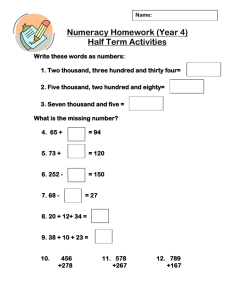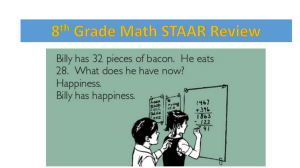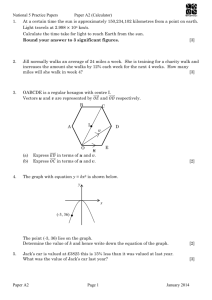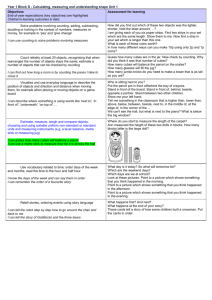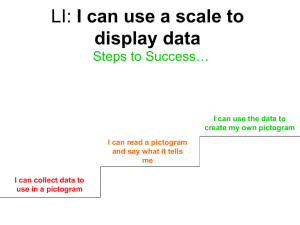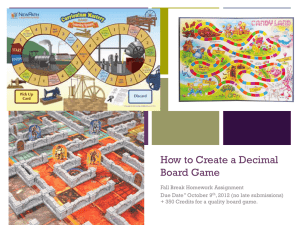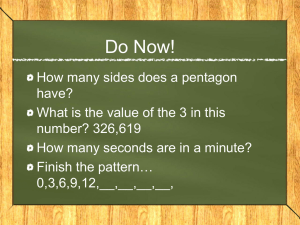Year 6 Block D - Calculating, measuring and understanding shape
advertisement
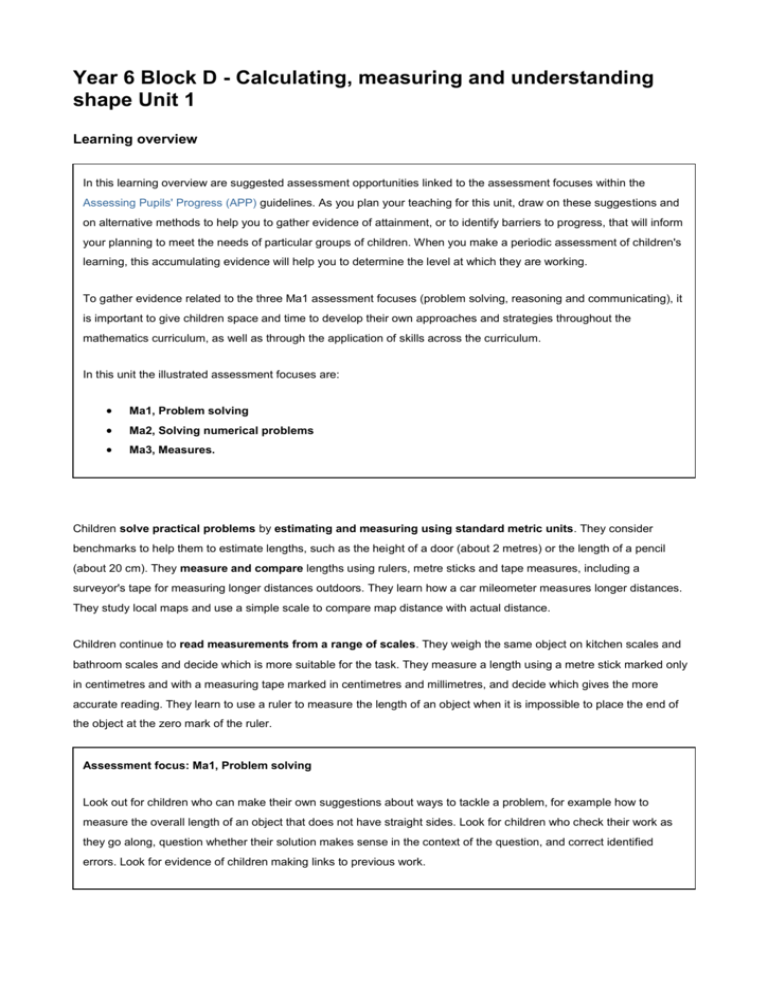
Year 6 Block D - Calculating, measuring and understanding shape Unit 1 Learning overview In this learning overview are suggested assessment opportunities linked to the assessment focuses within the Assessing Pupils' Progress (APP) guidelines. As you plan your teaching for this unit, draw on these suggestions and on alternative methods to help you to gather evidence of attainment, or to identify barriers to progress, that will inform your planning to meet the needs of particular groups of children. When you make a periodic assessment of children's learning, this accumulating evidence will help you to determine the level at which they are working. To gather evidence related to the three Ma1 assessment focuses (problem solving, reasoning and communicating), it is important to give children space and time to develop their own approaches and strategies throughout the mathematics curriculum, as well as through the application of skills across the curriculum. In this unit the illustrated assessment focuses are: Ma1, Problem solving Ma2, Solving numerical problems Ma3, Measures. Children solve practical problems by estimating and measuring using standard metric units. They consider benchmarks to help them to estimate lengths, such as the height of a door (about 2 metres) or the length of a pencil (about 20 cm). They measure and compare lengths using rulers, metre sticks and tape measures, including a surveyor's tape for measuring longer distances outdoors. They learn how a car mileometer measures longer distances. They study local maps and use a simple scale to compare map distance with actual distance. Children continue to read measurements from a range of scales. They weigh the same object on kitchen scales and bathroom scales and decide which is more suitable for the task. They measure a length using a metre stick marked only in centimetres and with a measuring tape marked in centimetres and millimetres, and decide which gives the more accurate reading. They learn to use a ruler to measure the length of an object when it is impossible to place the end of the object at the zero mark of the ruler. Assessment focus: Ma1, Problem solving Look out for children who can make their own suggestions about ways to tackle a problem, for example how to measure the overall length of an object that does not have straight sides. Look for children who check their work as they go along, question whether their solution makes sense in the context of the question, and correct identified errors. Look for evidence of children making links to previous work. Children convert between units as necessary, drawing on their knowledge of multiplying and dividing whole numbers and decimals by 10, 100 and 1000. For example, they give 3.2 litres in millilitres, 3544 g in kilograms, 2.1 metres in mm, 385 minutes in hours and minutes or 3.2 hours in hours and minutes. Children have an occasional opportunity to work with imperial units still in everyday use (such as pints or miles). They know the approximate equivalent metric values of these units and use these to make simple conversions. For example, they use the fact that 5 miles is approximately 8 kilometres to work out the approximate length of a 15 mile walk in kilometres. Children extend their understanding of area and perimeter. They estimate the area of irregular shapes by counting squares. For example, they estimate the area of a banana skin using an acetate grid. They use centimetre squared paper to draw an L-shape or a T-shape with an area of, say, 22 cm2. They calculate the area of an L-shaped garden, using their knowledge of the area of a rectangle, and the length of fence needed for its boundary. Which two shapes are equal in area? How do you know? Assessment focus: Ma3, Measures Look for evidence of children understanding area as a measure of surface, and perimeter as a measure of length, and who consistently state appropriate units for each; for example, square centimetres (cm 2) and centimetres (cm). Look out for the counting strategies children use, for example, when using a transparent grid of square centimetres to find the area of irregular shapes. Look for evidence of children finding the area of a rectangle by counting the number of squares in a row and multiplying this by the number of rows, and for children who begin to generalise this into 'length multiplied by breadth', for example. Look out for children working out the area of shapes that can be divided into rectangles, when the shapes are drawn on squared paper and all edge lengths and units of area can be seen. Look for children who solve similar problems when the shapes are drawn on plain paper and some dimensions are given. Look for evidence of children calculating 'missing' dimensions. Children solve multi-step problems involving measures. They decide what calculation(s) to do and estimate the answers. They choose appropriate and efficient methods, including mental methods, and using a calculator where appropriate. They check their answers against their estimates and consider them in the context of the problem, to make sure that they are reasonable. They compare different methods and justify their choices. For example, they solve problems such as: The temperature inside an aeroplane is 20 C. The temperature outside the aeroplane is –30 C. What is the difference between these temperatures? The area of a rectangle is 16 cm2. One of the sides is 2 cm long. What is the perimeter of the rectangle? Peanuts cost 60p for 100 grams. What is the cost of 350 grams of peanuts? Raisins cost 80p for 100 grams. Jack pays £2 for a bag of raisins. How many grams of raisins does he get? Assessment focus: Ma2, Solving numerical problems Look for evidence of children's proportional reasoning. Look for the way in which children solve problems involving direct proportion. For example, when they solve problems about cost per unit of weight, look for children who scale up and those children who begin to use a sequence of calculator key presses including multiplication and division, for example: 80p buys 100 g of raisins 80 p buys 100 g 80p buys 100 g 160p buys 200 g £2 = 2 ½ × 80p £2.00 buys 100 g × (200 ÷ 80) = 25g £2.00 - £1.60 = 40p £2 buys 2 ½ × 100 g 40p buys 50 g £2 buys 200 g + 50 g = 250 g Objectives End-of-year expectations (key objectives) are emphasised and highlighted Children's learning outcomes are emphasised Assessment for learning Solve multi-step problems, and problems involving fractions, decimals and percentages; choose and use appropriate calculation strategies at each stage, including calculator use Each tile is 4 centimetres by 9 centimetres. I can solve problems with several steps and decide how to carry out the calculation Here is a design made with the tiles. Calculate the width and height of the design. Write down the calculations that you did. Did you use a written method or a calculator? Explain why. Calculate mentally with integers and decimals: U.t ± U.t, TU × U, TU ÷ U, U.t × U, U.t ÷ U I can add, subtract, multiply and divide whole numbers and decimals in my head Use efficient written methods to add and subtract integers and decimals, to multiply and divide integers and decimals by a one-digit integer, and to multiply two-digit and threedigit integers by a two-digit integer I can add, subtract, multiply and divide whole numbers and decimals using efficient written methods Use a calculator to solve problems involving multi-step calculations I can use a calculator to solve problems with several steps Use approximations, inverse operations and tests of divisibility to estimate and check results I can estimate the result of a calculation I know several ways of checking answers Select and use standard metric units of measure and convert between units using decimals to two places (e.g. change 2.75 litres to 2750 ml, or vice versa) I can convert one measurement to another using a related unit. I use decimals to do this Solve problems by measuring, estimating and calculating; measure and calculate using imperial units still in everyday use; know their approximate metric values I know that 1 pint is just over half a litre, and that 1 litre is about 13/4 pints I know that 1 mile is about 1.6 km, and that 1 km is about 5/ of a mile 8 Which of these subtractions can you do without writing anything down? Why is it possible to solve this calculation mentally? What clues did you look for? I need two shelves each 1.4 metres in length. I cut the two shelves from a plank 5 metres long. How much of the plank is left? Explain the mental calculations that you did to solve this problem. Show me the calculation that you would do to solve this problem. A bottle holds 1 litre of lemonade. Rachel fills 5 glasses with lemonade. She puts 150 millilitres in each glass. How much is left in the bottle? What key presses would you make on a calculator to work out 2 × (21.9 8.7)? Peter has £10. He buys 3 kg of potatoes at 87p per kg and 750 g of tomatoes at £1.32 per kg. How much money does he have left? Show me how you used your calculator to find the answer. Roughly, what will the answer to this calculation be? How do you know that this calculation is probably right? Could you check it a different way? Should the answer be odd or even? How do you know? What units are used to measure capacity? Roughly what is the capacity in millilitres of a typical coffee mug? (250 to 300 ml) Of an egg cup? (50 ml) Of a teaspoon? (5 ml) What is the capacity in litres of a kitchen bucket? (about 10 litres) What units are used to measure weight? Roughly what is the average weight of newborn baby? (3 to 4 kg) Of a medium-sized chicken? (2 kg) Of an apple? (150 to 200 g) Of one lump of sugar? (5 g) What units are used to measure length? Roughly what is the height of the classroom door? (2 m) The length of a piece of A4 paper? (30 cm) The width of the palm of your hand? (7 to 8 cm) How many pints are about the same as one litre? Ring the best answer: 1 2 3 4 5 Write the correct whole number in the box. 5 miles is approximately kilometres. Read and interpret scales on a range of measuring instruments, recognising that the measurement made is approximate and recording results to a required degree of accuracy; compare readings on different scales, for example when using different instruments Here are a pencil sharpener, a key and an eraser. I can read scales as accurately as a problem requires I can compare readings from different scales What is the length of the key? Give your answer in millimetres. The diagram shows the volume of water in two measuring jugs. Which jug contains more water, A or B? How much more does it contain? Explain how you worked it out. Calculate the perimeter and area of rectilinear shapes; estimate the area of an irregular shape by counting squares I can find the perimeter and area of shapes and estimate the area of irregular shapes Use a range of oral techniques to present persuasive argument I can use different techniques to persuade people Tell me a rule for working out the area of a rectangle. Will it work for all rectangles? The area of a rectangle is 32 cm2. What are the lengths of the sides? Are there other possible answers? Show me something that has an area of approximately 100 cm2. What did you use to help you? Estimate the area of the front cover of this paperback book. How did you go about doing that? Convince your partner that a good estimate for the perimeter of the classroom is 25 metres, and that a good estimate for its area is 35 square metres. Tim says a square with sides of 8 cm has an area of 32 cm2. Do you agree with him? Why or why not?

